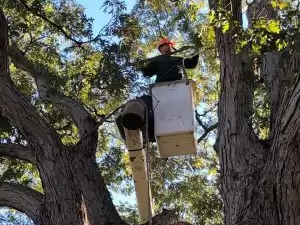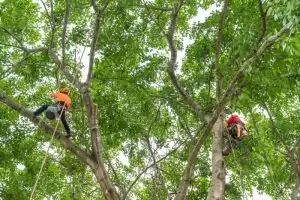Ficus trees, with their lush green leaves and elegant branches, are a popular choice among indoor plant enthusiasts. These tropical beauties not only enhance the aesthetics of your living space but also contribute to better indoor air quality. However, like any other plant, ficus trees require proper care and maintenance to thrive, and one crucial aspect of this care is trimming.
Trimming a ficus tree might seem daunting at first, but with the right knowledge and techniques, you can keep your ficus looking healthy and vibrant. In this comprehensive guide, we'll walk you through the process of trimming a ficus tree step by step, providing you with valuable insights and tips to ensure your plant flourishes.
When to Trim a Ficus Tree?
Trimming your ficus tree at the right time is essential for its overall health and vigor. Timing plays a crucial role in ensuring that the tree can recover and continue to thrive after pruning. In this section, we'll explore the best times of the year to trim your ficus tree and discuss signs that indicate it's time for a trim.
Best Times to Trim Your Ficus Tree
Spring: Spring is generally the ideal time to trim your ficus tree. During this season, the tree is entering its active growth phase, and trimming encourages new growth. Aim to prune in early to mid-spring, just before the tree's growth spurts.
Late Winter: If you prefer, you can also trim your ficus tree in late winter, right before the arrival of spring. This timing allows you to shape the tree before it starts its vigorous growth for the season.
Avoid Winter and Fall: It's generally best to avoid trimming your ficus tree during the winter months or in the fall. During these times, the tree tends to be in a semi-dormant state, and pruning may stress it more than during its active growing season.
Signs That Your Ficus Tree Needs Trimming
While choosing the right time of year to trim your ficus tree is crucial, it's equally important to recognize the signs that indicate it's time for a trim. Here are some common signals that your ficus tree may benefit from pruning:
Overgrowth: If your ficus tree has become too tall or wide for its designated space, it's time to trim it back. Overgrowth can affect its overall health and aesthetics.
Leggy Growth: Leggy growth refers to long, spindly branches with sparse foliage. Trimming can help encourage denser growth and a more compact shape.
Drooping Branches: If you notice branches that are drooping or touching the ground, trimming them can prevent damage and improve the tree's appearance.
Diseased or Dead Branches: Dead or diseased branches should be promptly removed to prevent the spread of disease and enhance the tree's health.
Crowded Canopy: If the foliage of your ficus tree is becoming too dense, it can limit air circulation and light penetration, potentially leading to issues like mold or pests. Trimming can open up the canopy and promote better airflow.
Importance of Timing
Timing your ficus tree trimming correctly is not just about ensuring the tree's health; it's also about maximizing its recovery and growth. When you trim during the recommended seasons, the ficus has the opportunity to allocate its energy towards new growth and healing, resulting in a healthier and more vibrant plant.
In the next section, we'll explore the essential tools and materials you'll need to trim your ficus tree effectively. Proper tools and preparation are key to a successful trimming process.
Stay tuned for the next section, where we'll discuss the tools and materials required for trimming your ficus tree and how to prepare for the task.
Tools and Materials to Trim a Ficus Tree
Before you embark on the journey of trimming your ficus tree, it's essential to gather the right tools and materials. Having the correct equipment ensures that the pruning process is efficient, safe, and beneficial for your plant. In this section, we'll list the essential tools and materials you'll need and provide guidance on how to prepare for the task.
Essential Tools for Ficus Tree Trimming
Pruning Shears or Scissors: High-quality pruning shears or scissors are a must for precision trimming. They come in various sizes, so choose ones that are suitable for your ficus tree's branches.
Gloves: Wear gardening gloves to protect your hands from sharp branches and any potential irritants from the ficus tree's sap.
Safety Goggles: Safety goggles or glasses are important to shield your eyes from falling debris and sharp branches.
Optional Tools for Specific Situations
Loppers: If your ficus tree has thicker branches, loppers with longer handles can provide more leverage for clean cuts.
Hand Saw: For very thick branches that cannot be pruned with shears or loppers, a small hand saw may be necessary.
Rubbing Alcohol or Hydrogen Peroxide: To disinfect your cutting tools between cuts, preventing the spread of diseases.
Materials for Cleanup and Maintenance
Pruning Paste or Sealant: While not essential, pruning paste or sealant can be used to cover large cuts and promote healing. This is particularly useful for preventing infection in larger wounds.
Trash Bags or Containers: Have trash bags or containers on hand to collect the trimmings and keep your workspace tidy.
Preparing for Ficus Tree Trimming
Inspect Your Ficus Tree: Before you begin, carefully inspect your ficus tree. Identify the branches that need trimming and make a plan for the cuts you intend to make. This will help you achieve your desired shape and maintain the tree's health.
Clean and Sharpen Tools: Ensure that your pruning shears or scissors are clean and sharp. Clean them with rubbing alcohol or hydrogen peroxide to disinfect them, and sharpen the blades if necessary.
Select a Suitable Location: Perform the trimming in a well-ventilated area, such as a patio or garden. Trimming indoors can lead to a mess and sap spillage that can be difficult to clean up.
Protect Your Work Surface: Lay down a drop cloth or newspapers to catch any debris and make cleanup easier.
Wear Protective Gear: Put on your gardening gloves and safety goggles before you start trimming to protect yourself from scratches and debris.
Plan Your Cuts: Start with a clear plan in mind. Decide which branches to prune, and aim for clean, precise cuts. Avoid removing more than one-third of the plant's foliage in a single pruning session to minimize stress on the ficus.
With the right tools, materials, and preparation, you're now ready to move on to the practical aspects of trimming your ficus tree. In the next section, we'll guide you through the step-by-step process of trimming, ensuring that your ficus stays healthy and beautiful.
How to Trim a Ficus Tree: Step-by-Step Guide
Now that you've gathered the necessary tools and materials and prepared your ficus tree for trimming, let's dive into the step-by-step process of trimming your ficus tree effectively. Proper technique is key to ensuring the health and aesthetics of your plant.
1. Start with Removing Dead or Damaged Branches:
- Identify Dead Branches: Begin by identifying any branches that are clearly dead or have no signs of life. Dead branches are often dry, brittle, and discolored.
- Make Clean Cuts: Use your pruning shears or scissors to make clean cuts just above the branch collar (the swollen area where the branch meets the trunk). Avoid leaving stubs, as they can be entry points for diseases.
- Dispose of Dead Branches: Collect the removed dead branches in your trash bag or container and dispose of them properly.
- Address Overgrowth and Leggy Growth:
- Shaping: To shape your ficus tree, begin by trimming the longer branches to encourage a more compact form. Snip off the tips of branches to the desired length.
- Height Reduction: If your ficus has grown too tall, prune the top branches to reduce its height. This can be done by cutting back to a healthy lateral branch or node.
- Promote Denser Growth: To encourage denser growth, pinch or prune the tips of branches. This stimulates branching and results in a fuller canopy.
- Promote New Growth:
- Branching: Observe your ficus tree's growth pattern and encourage the development of new branches by pruning just above a healthy bud or node. This helps create a bushier appearance.
- Pinching: In addition to pruning, consider pinching off the tips of branches between your thumb and forefinger. This promotes branching and a more compact shape.
2. Special Considerations for Ficus Bonsai Trees:
If you're trimming a ficus bonsai tree, the process will be similar but more precise. Bonsai trees require meticulous shaping and maintenance to achieve their miniature, artistic forms. Research specific techniques for pruning and shaping bonsai trees to ensure you achieve the desired results.
Step-By-Step Tips:
- Make clean, angled cuts to prevent water from collecting on the wound.
- Avoid cutting too close to the trunk, as this can damage the tree's growth.
- Disinfect your tools between cuts to prevent the spread of disease.
- Step back periodically to assess the tree's shape and progress.
- If you're unsure about a cut, it's often better to make smaller cuts initially and reassess before removing more.
Remember that ficus trees are resilient and can recover from pruning, so don't be afraid to trim as needed to achieve your desired look and size.
Aftercare and Maintenance for Your Trimmed Ficus Tree
Trimming your ficus tree is just one part of the equation. Proper aftercare and ongoing maintenance are essential to ensure your tree remains healthy, vibrant, and continues to thrive. In this section, we'll discuss the post-trimming steps and routine maintenance tasks to keep your ficus looking its best.
1. Watering:
Consistent Moisture: Ficus trees prefer consistently moist soil. Water your ficus when the top inch of soil feels dry to the touch, but avoid letting the plant sit in waterlogged soil, as this can lead to root rot.
Watering Frequency: The frequency of watering depends on factors like the size of the pot, the season, and the humidity levels in your home. Adjust your watering schedule accordingly to maintain even moisture.
2. Fertilizing:
Balanced Fertilizer: Use a balanced, water-soluble fertilizer with equal parts nitrogen (N), phosphorus (P), and potassium (K). Fertilize your ficus every 2-4 weeks during the growing season (spring and summer) and reduce to once a month during fall and winter.
Follow Instructions: Always follow the manufacturer's instructions on the fertilizer label, and avoid over-fertilizing, as it can harm your ficus.
3. Pruning Maintenance:
Regular Inspections: Periodically inspect your ficus for any new growth that needs shaping or dead/diseased branches that require removal.
Pinching: Continue to pinch the tips of branches to encourage branching and maintain a compact shape.
4. Repotting (as needed):
Assess Rootbound Plants: If your ficus has outgrown its pot or appears rootbound (roots circling around the root ball), consider repotting it into a slightly larger container. Repotting is typically needed every 2-3 years.
Fresh Potting Mix: Use a well-draining potting mix suitable for ficus trees when repotting. Gently loosen the roots and provide fresh soil to encourage healthy growth.
5. Monitoring for Pests and Diseases:
Keep an Eye Out: Regularly inspect your ficus for signs of pests such as mealybugs, spider mites, or scale insects. Also, watch for symptoms of fungal diseases like leaf spot or powdery mildew.
Early Intervention: If you notice any issues, address them promptly. Isolate infected plants, remove affected leaves, and treat the problem with appropriate solutions (insecticidal soap for pests, fungicides for diseases).
6. Environmental Considerations:
Light: Ensure your ficus receives the appropriate amount of light. Most ficus varieties prefer bright, indirect sunlight but can adapt to lower light conditions. Avoid exposing them to direct, intense sunlight, which can scorch their leaves.
Temperature and Humidity: Ficus trees thrive in a stable indoor environment with temperatures between 65-75°F (18-24°C) and moderate humidity. Protect them from drafts and extreme temperature fluctuations.
7. Patience and Observation:
Monitor Growth: Be patient and monitor your ficus tree's growth. It may take some time for it to bounce back from the pruning process and develop a fuller canopy.
Adjust Care: Adjust your care routine based on how your ficus tree responds to trimming and environmental conditions. Every plant is unique, and its needs may vary.
By following these aftercare and maintenance guidelines, you'll help your ficus tree recover from trimming and continue to thrive. Remember that patience and consistent care are key to maintaining a healthy and beautiful ficus tree.
Common Mistakes to Avoid When Trimming Your Ficus Tree
While trimming your ficus tree can be beneficial for its health and appearance, it's essential to avoid common mistakes that can harm your plant or result in undesirable outcomes. In this section, we'll highlight some common pitfalls to watch out for when trimming your ficus tree and provide tips on how to avoid them.
Over-Pruning:
Mistake: Removing too many branches or foliage at once can stress your ficus tree, leading to slow growth or even shock.
Avoidance: Start with light pruning, and assess the tree's response before making more cuts. Avoid removing more than one-third of the foliage in a single session.
Poor Pruning Technique:
Mistake: Making rough or uneven cuts, leaving stubs, or damaging the branch collar can hinder proper healing and lead to disease or pest issues.
Avoidance: Use sharp, clean pruning shears or scissors to make clean cuts just above the branch collar. Angle your cuts to shed water and promote healing.
Neglecting Disinfection:
Mistake: Failing to disinfect your pruning tools between cuts can spread diseases from one branch to another.
Avoidance: Wipe your pruning tools with rubbing alcohol or hydrogen peroxide between cuts to prevent cross-contamination.
Pruning at the Wrong Time:
Mistake: Trimming your ficus tree during its dormant or stressed periods (fall and winter) can lead to slow recovery and growth.
Avoidance: Time your pruning sessions for spring or late winter when the tree is entering an active growth phase.
Using Dull Tools:
Mistake: Dull pruning shears or scissors can result in jagged cuts, causing unnecessary stress to the plant.
Avoidance: Ensure your cutting tools are sharp and well-maintained to make clean, precise cuts.
Neglecting Aftercare:
Mistake: Failing to provide proper post-trimming care, including watering, fertilizing, and monitoring, can hinder your ficus tree's recovery.
Avoidance: Follow the aftercare and maintenance guidelines mentioned earlier in this guide to ensure your ficus remains healthy and vibrant.
Not Assessing the Overall Shape:
Mistake: Focusing solely on individual branches without considering the overall shape of your ficus tree can result in an unbalanced or unsightly appearance.
Avoidance: Step back periodically during trimming to assess the tree's shape and make adjustments as needed to achieve your desired form.
Overcrowding the Canopy:
Mistake: Allowing the foliage to become too dense can limit air circulation and light penetration, potentially leading to mold or pest problems.
Avoidance: Thin out the canopy by removing some interior branches, allowing better airflow and light distribution.
Rushing the Process:
Mistake: Hasty pruning without careful consideration can lead to undesirable results.
Avoidance: Take your time and plan your cuts before you start trimming. This ensures that you achieve the desired shape and maintain the plant's health.
Ignoring Signs of Stress:
Mistake: Failing to notice signs of stress or disease after trimming can result in further issues going untreated.
Avoidance: Regularly inspect your ficus tree post-trimming for any signs of stress, disease, or pests. Address issues promptly to prevent them from spreading.
By avoiding these common mistakes and following the best practices outlined in this guide, you can ensure a successful ficus tree trimming experience that enhances the health and aesthetics of your beloved indoor plant.
Conclusion
In this comprehensive guide, we've explored the art of trimming your ficus tree to promote its health, shape, and overall beauty. Ficus trees are a beloved addition to indoor spaces, but they require care and attention to thrive. Proper trimming is a fundamental part of that care.
Remember that ficus trees are resilient and can bounce back from pruning when done correctly. It may take some time for your plant to fully recover and develop the desired shape, so exercise patience and continue to care for it diligently.
Your ficus tree is not just a houseplant; it's a living, breathing part of your indoor environment. With proper trimming and care, it will reward you with its lush foliage, adding natural beauty and freshness to your home.
We hope this guide has equipped you with the knowledge and confidence to trim your ficus tree effectively. Now, it's your turn to take action and start caring for your ficus with the skills you've gained.




